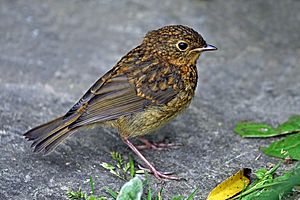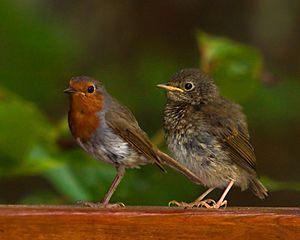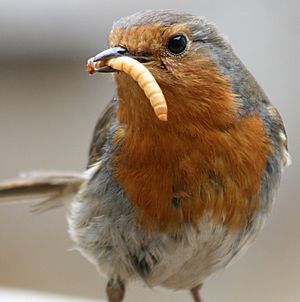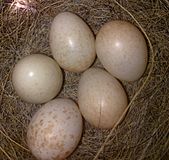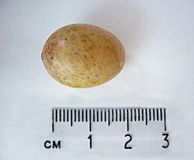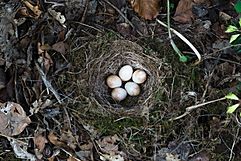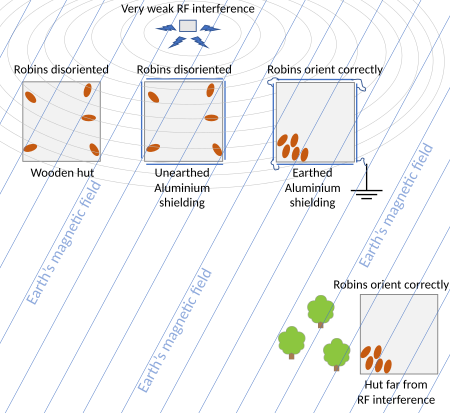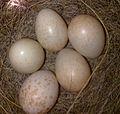European robin facts for kids
Quick facts for kids European robin |
|
|---|---|
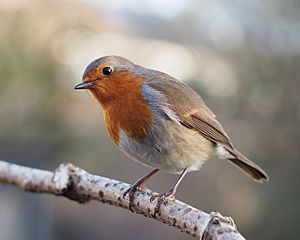 |
|
| Conservation status | |
| Scientific classification | |
| Genus: |
Erithacus
|
| Species: |
rubecula
|
| Subspecies | |
|
7–10, see text. |
|
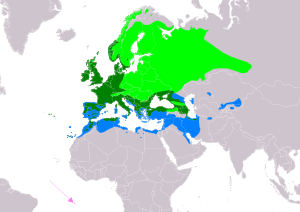 |
|
| Where the European Robin lives: Breeding areas Lives there all year Wintering areas Possibly extinct or introduced | |
| Synonyms | |
|
|
The European robin (Erithacus rubecula), often just called the robin or robin redbreast in Great Britain and Ireland, is a small bird. It eats mostly insects. This bird belongs to the Old World flycatcher family. You can find it all over Europe, stretching east to Western Siberia and south to North Africa. Most robins stay in the same place all year, except for those in the far north.
Robins are about 12.5–14.0 cm (4.9–5.5 in) long. Male and female robins look very similar. They have an orange breast and face, with grey lines around them. Their upper parts are brown, and their belly is whitish.
Contents
Why is it Called a Robin?
The robin's bright orange chest is very easy to spot. People used to call it "redbreast" because the color "orange" wasn't a common word in English until the 1500s. That's when the fruit was brought to Europe. In many other languages, like French and German, the bird's name also means "redbreast" or "red throat."
Around the 1400s, people started giving human names to animals they knew well. That's how the "redbreast" became "robin redbreast," which was later shortened to just "robin." The name Robin is a smaller version of the name Robert.
You might hear other birds called "robin" too, but they are not the same species. For example, the American robin is a type of thrush, and the Australian robins are from a different bird family. They just happen to have similar red or orange chests.
Older English names for the European robin include ruddock and robinet. In old American books, this bird was often called the English robin.
What Kind of Bird is the Robin?
The European robin was first officially described by a scientist named Carl Linnaeus in 1758. He gave it the scientific name Motacilla rubecula. The word rubecula comes from Latin and means 'red'. Later, in 1800, another scientist named Georges Cuvier put the robin in its own group, or genus, called Erithacus. So, its full scientific name today is Erithacus rubecula. The name Erithacus comes from ancient Greek and was used for a bird that is now thought to be the robin.
The European robin used to be grouped with other robins from Asia, like the Japanese robin. But scientists studied their DNA and found that the Asian robins were more like other Asian birds. So, the Japanese and Ryukyu robins were moved to a different genus, leaving the European robin as the only one in the Erithacus group.
Scientists used to think the robin belonged to the thrush family. But now, they believe it's part of the Old World flycatcher family. This family also includes birds called chats, like the common nightingale.
Different Kinds of Robins
Robins that live across Europe are mostly similar. But robins living on islands or in mountains can be a bit different. For example, the robins in the British Isles and western Europe are called Erithacus rubecula melophilus.
Robins in the Canary Islands
The robins on the Canary Islands are the most unique. Those on Gran Canaria (E. r. marionae) and Tenerife (E. r. superbus) might even be considered different species! They have a white ring around their eyes, a very bright orange chest, and a grey line that separates the orange from the brown. Their belly is completely white.
Scientists have studied their DNA and songs. They found that the Gran Canaria and Tenerife robins are very different from mainland robins. They probably came from mainland birds about 2 million years ago. A study in 2003 suggested that the Gran Canaria robin separated from its European relatives about 2.3 million years ago. The Tenerife robin separated about 1.8 million years ago. This might mean that robins first arrived on Gran Canaria (the older island) and then moved to Tenerife.
Robins on the western Canary Islands (El Hierro, La Palma, and La Gomera) are more similar to the European robins. You can also find European robins on Fuerteventura in winter, but they don't breed there.
Other Birds Called "Robin"
The American robin (Turdus migratorius) is a much bigger bird. It's called a "robin" because it also has a reddish chest, but it's not closely related to the European robin. The American robin is in the same group as the common blackbird. The main similarity is just the orange patch on their chest. The American robin is very rarely seen in the UK.
Some thrushes in South and Central America are also called robins, like the rufous-collared thrush. In Australia, the "robin redbreast" is actually the scarlet robin (Petroica multicolor). It's more closely related to crows than to the European robin. There are also "magpie-robins" in Africa and Asia, like the Oriental magpie robin, which is the national bird of Bangladesh.
What Does a Robin Look Like?
An adult European robin is about 12.5–14.0 cm (4.9–5.5 in) long. It weighs between 16–22 g (0.56–0.78 oz), and its wingspan is about 20–22 cm (7.9–8.7 in). Both male and female robins look alike. They have a bright orange breast and face. This orange is outlined by a bluish-grey color on the sides of their neck and chest. Their upper body is brownish, and their belly is whitish. Their legs and feet are brown, and their beak and eyes are black.
Young robins look different. They are spotted brown and white. Over time, patches of orange feathers slowly appear on their chest until they look like adult robins.
Where Do Robins Live?
Robins live across Europe, stretching east to Western Siberia, and south to Algeria and the Atlantic islands like the Azores and Madeira. They are sometimes seen in Iceland. In the southeast, they reach Iran and the Caucasus mountains.
Robins in Ireland and Britain usually stay in the same place all year. However, a few, mostly females, fly to southern Europe for winter, some even going as far as Spain. Robins from Scandinavia and Russia fly to Britain and western Europe to escape the very cold winters. These migrating robins often have greyer upper bodies and duller orange chests. European robins that migrate prefer spruce forests in northern Europe, but in Great Britain, they like parks and gardens.
In southern Spain and Portugal, local robins stay in their breeding woodlands.
People tried to bring European robins to Australia and New Zealand in the late 1800s, but it didn't work. Birds were released in several cities, but none of them managed to settle and grow their population. The same thing happened in North America, where robins released in New York, Oregon, and British Columbia also failed to establish themselves.
How Do Robins Behave?
Robins are active during the day. Sometimes, they hunt insects at night if there's moonlight or artificial light. Gardeners in Britain and Ireland know robins well because they are not very afraid of people. Robins often come close when people are digging in the garden. They are looking for earthworms and other food that gets turned up from the soil. People often think of the robin as a gardener's friend. In some parts of Europe, however, robins were hunted, so they are more shy there. Robins also follow large wild animals, like wild boar, that disturb the ground, hoping to find food.
In autumn and winter, robins eat berries and fruit in addition to their usual diet. Their normal diet includes small creatures like spiders, worms, and insects. They will also eat seeds and suet (a type of fat) left out on bird feeders.
Male robins are known for being very protective of their territory. They will fiercely attack other male robins or other small birds that come into their area. Sometimes, they even attack their own reflection in a window! These fights can sometimes lead to deaths, accounting for up to 10% of adult robin deaths in some places.
Because many young robins don't survive their first year, a robin's average life is about 1.1 years. However, if a robin lives past its first year, it has a much better chance of living longer. One robin was recorded living for 19 years! Very cold winters can cause more robins to die.
Robin Life Cycle: Breeding
Robins can build their nests in many different places. They look for any spot that offers some shelter, like a hole or a dip in the ground. Besides natural places like cracks or sheltered banks, they might use unusual spots. These can include old machinery, barbecues, bicycle handlebars, brooms, kettles, watering cans, flower pots, and even hats! Robins will also nest in special nest boxes made by people. They prefer open-front boxes placed in a sheltered spot up to 2 metres (6 ft 7 in) off the ground. Nests are usually made of moss, leaves, and grass, with softer materials like fine grass, hair, and feathers inside.
Robins usually lay two or three sets of eggs during the breeding season, which starts in March in Britain and Ireland. Each set, called a clutch, has five or six eggs. The eggs are cream, buff, or white with reddish-brown speckles or blotches, often more concentrated at the wider end. When young birds first leave the nest, they are completely mottled brown. After two to three months, they start to grow orange feathers under their chin. Over a similar period, this orange patch grows until they have the full red-orange chest of an adult robin.
What Does a Robin Sound Like?
During the breeding season, the robin sings a beautiful, fluting, and warbling song. Both male and female robins sing in winter when they have their own separate territories. Their winter song sounds a bit sadder than their summer song. Female robins move a short distance from their summer nesting area to a nearby spot that's better for finding food in winter. Male robins usually stay in the same territory all year.
During breeding season, male robins typically start singing about an hour before sunrise and stop about thirty minutes after sunset. Sometimes, robins sing at night, especially in cities where there are bright lights. Some city robins choose to sing at night to avoid the noise from people during the day.
Scientists have studied how robins find their way. Robins can sense the Earth's magnetic field to navigate. This ability, called magnetoreception, is linked to their vision. The light entering their eyes helps them "see" the magnetic field. This amazing sense involves tiny particles in their eyes that are affected by the Earth's magnetism.
How Are Robins Protected?
The European robin lives in a very large area and has hundreds of millions of birds. Its population seems to be growing. Because of its wide range and large numbers, the International Union for Conservation of Nature (IUCN) lists the European robin as a species of "least concern." This means it is not currently in danger of disappearing.
Robins in Culture
Robins are very important in British stories and in some parts of France, but less so in other parts of Europe. In old Norse stories, the robin was thought to be a storm-cloud bird and sacred to Thor, the god of thunder. Robins also appear in the traditional children's story Babes in the Wood, where the birds cover the dead children with leaves.
The robin has become strongly connected with Christmas. You can see them on many Christmas cards since the mid-1800s. They have also appeared on many Christmas postage stamps. An old British folk tale tries to explain the robin's red chest. The legend says that when Jesus was dying on the cross, the robin, which was all brown then, flew to him and sang to comfort him. The blood from Jesus's wounds stained the robin's chest, and from then on, all robins carry that mark.
Another legend says its chest was burned while fetching water for souls in Purgatory. However, the connection with Christmas probably comes from a different reason. Postmen in Victorian Britain wore red jackets and were nicknamed "Robins." So, the robin on Christmas cards became a symbol of the postman delivering the card.
In the 1960s, the robin was chosen as the unofficial national bird of the United Kingdom in a public vote. In 2015, it was voted Britain's national bird again in a poll organized by birdwatcher David Lindo, getting 34% of the votes.
Several sports teams in England and Wales are nicknamed "the Robins." This nickname is usually for teams that wear red. These include football clubs like Bristol City, Crewe Alexandra, Swindon Town, and Cheltenham Town. Bristol City, Swindon Town, and Cheltenham Town even have a robin on their team badges. The English rugby league team Hull Kingston Rovers is also called "the Robins." A small bird might seem like an unusual choice, but it's thought to represent being quick and agile on the field.
Images for kids
See also
 In Spanish: Petirrojo europeo para niños
In Spanish: Petirrojo europeo para niños



